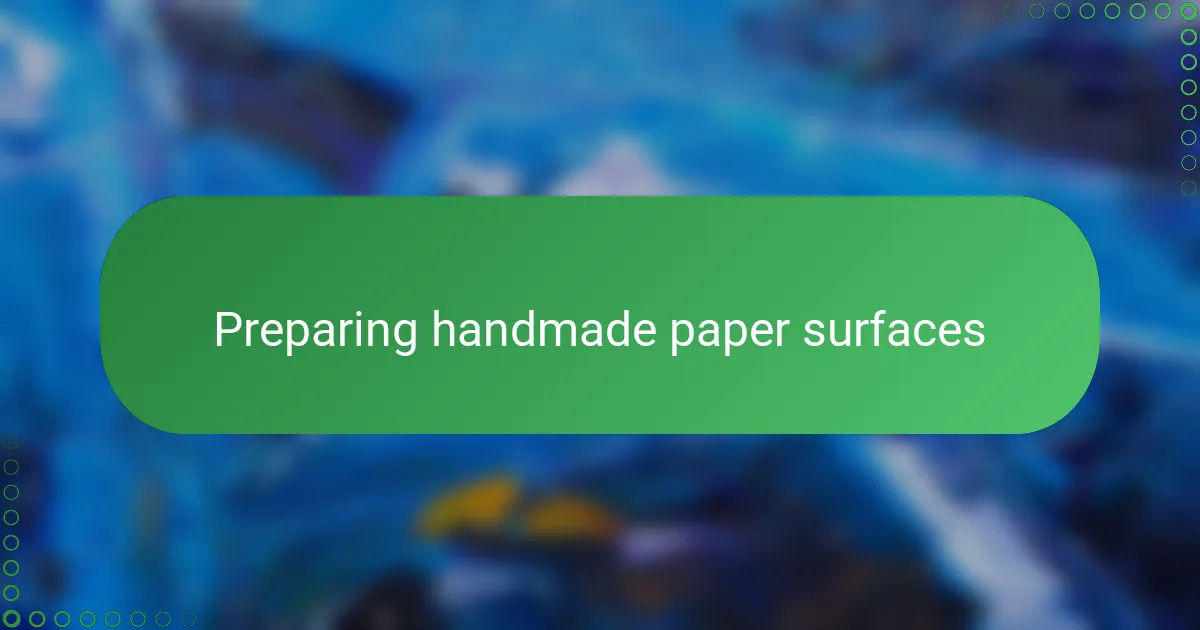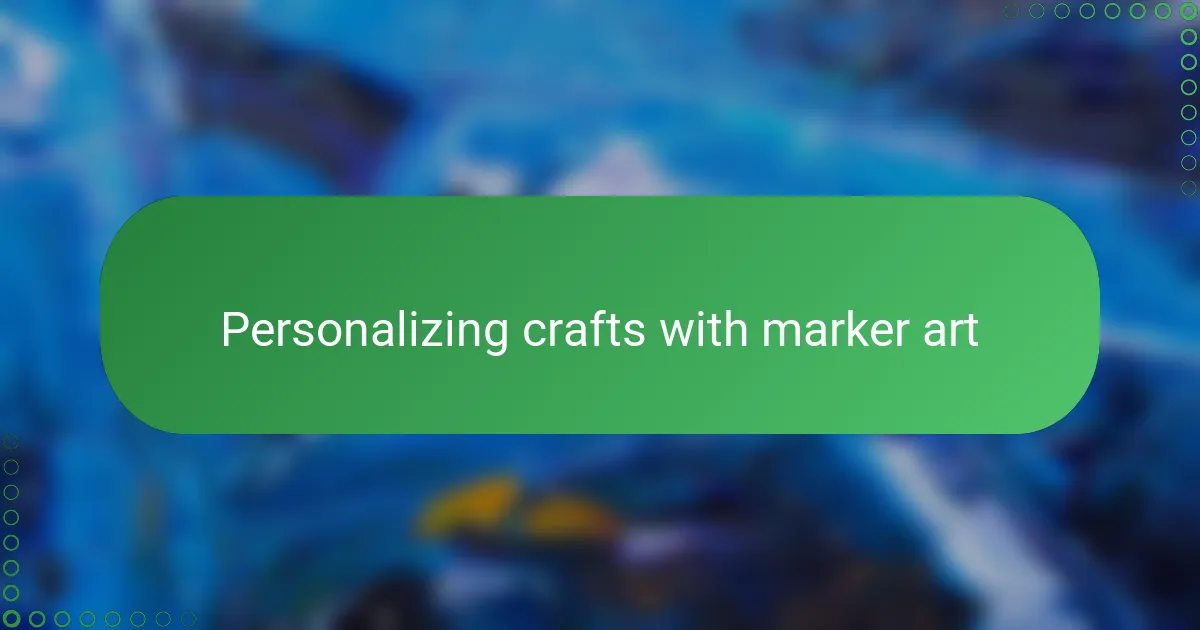Key takeaways
- Fine-tip markers enable precise, detailed designs, essential for enhancing intricate paper crafts.
- Choosing the right ink formula and marker characteristics, like ergonomic design, can significantly improve crafting experience.
- Preparing the paper surface and using varying pressure techniques enhance the quality of the artwork.
- Personalizing crafts with meaningful details transforms items into unique keepsakes, fostering a deeper connection to the work.

Understanding fine-tip markers
Fine-tip markers have always fascinated me with their precision and control. Their slender, pointed tips allow for detailed lines and intricate designs that broader markers simply can’t achieve. Have you ever noticed how they make even the tiniest embellishments pop on handmade paper?
When I first tried using fine-tip markers, I was amazed at how effortlessly they glided across textured paper without bleeding. This made me realize their unique ability to enhance delicate craft projects, especially where subtlety matters. Isn’t it satisfying when your tools match the finesse of your work?
Understanding the types of fine-tip markers and their ink qualities helped me choose the right ones for different effects—ranging from vibrant, permanent pigment to softer, blendable tones. Getting familiar with these nuances really transformed the way I approach my paper crafts, adding layers of depth and personality to each piece.

Choosing markers for paper crafts
Choosing markers for paper crafts starts with thinking about how the ink interacts with the paper. From my experience, markers with quick-drying, non-bleeding ink save so much frustration, especially on handmade paper which can be absorbent or uneven. Have you ever dealt with colors smudging or bleeding into delicate fibers? Choosing the right ink formula makes all the difference in preserving crisp lines.
I also consider the finish and opacity of the markers. I tend to prefer pigment-based markers because they offer vibrant, long-lasting color without fading, which really brings my designs to life. When I switched to them, my projects felt more polished and professional, and I noticed how the colors stood out beautifully against the textured surfaces.
Something else I look for is comfort in handling the markers since long crafting sessions can strain the hands. Fine-tip markers with ergonomic barrels and a good balance feel like an extension of my creativity. Don’t you find that having tools that feel right boosts your flow and enjoyment? This little detail often influences how smoothly a project comes together.

Preparing handmade paper surfaces
Preparing handmade paper surfaces always feels like setting the stage for a delicate performance. I’ve learned that lightly smoothing the paper with fine sandpaper can make a surprisingly big difference. It reduces some of the natural bumps, giving fine-tip markers a cleaner path without compromising that lovely handmade texture.
Sometimes, I apply a subtle primer or sizing to the paper, especially if the surface feels too porous. This step helps the ink stay put, preventing those tiny feathers of color that can blur detailed designs. Have you ever experienced your carefully drawn lines bleeding unpredictably? That’s where prepping really pays off.
I also pay close attention to the moisture content of the paper before starting. Paper that’s too damp or uneven can cause ink to spread, and trust me, nothing kills my creative flow like having to redo lines. Letting the paper dry thoroughly after any treatment ensures my fine-tip markers work exactly how I want them to—crisp, clean, and vibrant.

Techniques for using fine-tip markers
When I use fine-tip markers, one technique I swear by is varying the pressure I apply. Light pressure gives me delicate, almost whisper-thin lines perfect for intricate patterns, while a bit more pressure creates bolder strokes that really stand out. Have you ever noticed how just a slight change in pressure can totally transform a design’s feel? It’s like telling a story with every stroke.
Layering colors is another method that has brought my paper crafts to life. I like to start with a light base and gently add darker shades on top, building depth without overwhelming the delicate paper. This gradual approach lets me blend tones smoothly, which is especially satisfying when working on textured handmade sheets. Isn’t it rewarding to see simple lines develop into rich, dimensional art?
Finally, I’ve found that using fine-tip markers with a steady hand—and sometimes a guiding stencil—makes a huge difference. At first, my lines would waver, but practicing slow, deliberate movements helped me gain control and confidence. Don’t you think mastering these subtle techniques turns your marker from just a tool into a real extension of your creativity?

Designing detailed paper craft projects
Designing detailed paper craft projects often feels like piecing together a delicate puzzle. I find myself sketching tiny motifs and intricate borders that require patience and a steady hand. Have you ever experienced the satisfaction of watching those fine lines come alive, transforming a blank sheet into a mini masterpiece?
I like to break down complex designs into smaller, manageable sections. This approach keeps me focused and prevents feeling overwhelmed by the tiny details. When I work this way, the whole project feels less daunting, and each detail has room to breathe.
Sometimes, the challenge lies in balancing detail with harmony. I’ve learned to step back frequently, ensuring my intricate patterns don’t overpower the paper’s natural texture. It’s almost like a dance between control and letting the handmade paper’s character shine through. Have you noticed how the best designs respect both precision and organic imperfections?

Personalizing crafts with marker art
Personalizing crafts with marker art feels like adding a signature touch that truly makes each piece mine. When I pick up a fine-tip marker, I’m not just coloring — I’m telling a story through delicate lines and subtle shading. Have you ever felt that moment when a simple doodle suddenly breathes life into your paper, making it unmistakably yours?
I often start by writing little messages or drawing tiny symbols that hold personal meaning. These small details, like initials or meaningful icons, may seem modest, but they create a unique connection between my craft and my story. It’s remarkable how a few strokes with a fine-tip marker can transform a generic item into a heartfelt keepsake.
Sometimes I like to experiment with layering handwritten notes and decorative borders to frame my designs. This layering not only adds depth but also invites viewers to look closer and discover the personal touches hidden within. Don’t you find that these subtle customizations make your handmade papers feel more alive and intimate?

Maintaining and storing markers
Storing my fine-tip markers properly has become almost as important as using them. I always make sure to keep them capped tightly and stored horizontally; this simple habit prevents the ink from drying out unevenly, which I’ve learned the hard way when some markers refused to write smoothly after being left uncapped. Have you ever picked up a marker only to find it scratchy and dry? It’s such a letdown when that happens mid-project.
Another thing I pay attention to is avoiding extreme temperatures. I remember one summer when I left my markers in a hot car overnight, and the ink consistency changed—it was less vibrant and harder to control. Keeping them in a cool, dry place ensures the colors stay true and the tips remain in good shape, ready whenever creativity strikes.
Maintaining your markers doesn’t have to be complicated. Occasionally, I gently wipe the tips with a damp cloth to remove any built-up residue, which keeps lines crisp and prevents clogging. This little bit of care extends their lifespan and keeps each stroke feeling fresh—don’t you love that feeling when your tools perform exactly as expected?
